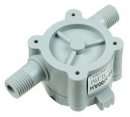Iot Tank Sensor Project
Caution... Very geeky intensive thread......
The Internet of Things (IoT) is a concept designed to publish geographically distributed sensor/data online. Thus the technology is generally small low powered and obviously wifi enabled. The raspberrypi is overkill for such a requirement, too big and power hungry, arduino is small enough however Ethernet/wifi shields are expensive. Over the last 12 months a Chinese manufacturer released a wifi enabled device ESP8622 that has a small amount of IO and can serve this data out via html pages. More recently there is now applications that allow you to program the device similar to the arduino. So for $15.00 you now have available a wifi device that has quite a competent microprocessor onboard that we can easily program.
ESP8266. 16 GPIO pins

Application.....
I currently use a raspberrypi to provide trending for tank sensors which is very reliable. The RPi provides a full web server and does the data collection and trending / display of tank parameters. However what if the sensors are not close to the raspberrypi and too far or impractice to wire up or you have lots of tanks. We can use a esp8266 to gather data, do a little scaling and provide this data to whoever wants it. The RPi can easily log into the esp8266 and retrieve the data and then trend this locally. I have been using this philosophy for the past 18 months, I have no sensors connected to my RPi anymore however log into my profilux web page and retrieve the sensor data from it so I can store this within my RPi. Same principal applies to a esp8266 as it too is a micro web server.
Capability......
The esp8266 has 16 IO which can control outputs and connect various sensors. The simpler sensors are temperature sensors ds18b20 or the dht22 humidity/temp. Digital switch (float), digital outputs or what I am initially interested in pulse input. An LCD screen can also be attached to display data locally...
My 1st Device to test....
I already have a couple of small flow meters (futurlec web site 8l/hr. <$10.00) which I have always wanted to put on my ATO and AWC lines. The flow meters are simple devices and provide a number of pulses per litre. So the only thing you have to do is count the pulses, multiply by a factor to get litres then publish the data. I will probably also add humidity and temp as I have a spare dht22 sensor. The flow meters and esp8266 will be located outside and hopefully in range of my home wifi.
Possibilities ......
Endless :)
The Internet of Things (IoT) is a concept designed to publish geographically distributed sensor/data online. Thus the technology is generally small low powered and obviously wifi enabled. The raspberrypi is overkill for such a requirement, too big and power hungry, arduino is small enough however Ethernet/wifi shields are expensive. Over the last 12 months a Chinese manufacturer released a wifi enabled device ESP8622 that has a small amount of IO and can serve this data out via html pages. More recently there is now applications that allow you to program the device similar to the arduino. So for $15.00 you now have available a wifi device that has quite a competent microprocessor onboard that we can easily program.
ESP8266. 16 GPIO pins
Application.....
I currently use a raspberrypi to provide trending for tank sensors which is very reliable. The RPi provides a full web server and does the data collection and trending / display of tank parameters. However what if the sensors are not close to the raspberrypi and too far or impractice to wire up or you have lots of tanks. We can use a esp8266 to gather data, do a little scaling and provide this data to whoever wants it. The RPi can easily log into the esp8266 and retrieve the data and then trend this locally. I have been using this philosophy for the past 18 months, I have no sensors connected to my RPi anymore however log into my profilux web page and retrieve the sensor data from it so I can store this within my RPi. Same principal applies to a esp8266 as it too is a micro web server.
Capability......
The esp8266 has 16 IO which can control outputs and connect various sensors. The simpler sensors are temperature sensors ds18b20 or the dht22 humidity/temp. Digital switch (float), digital outputs or what I am initially interested in pulse input. An LCD screen can also be attached to display data locally...
My 1st Device to test....
I already have a couple of small flow meters (futurlec web site 8l/hr. <$10.00) which I have always wanted to put on my ATO and AWC lines. The flow meters are simple devices and provide a number of pulses per litre. So the only thing you have to do is count the pulses, multiply by a factor to get litres then publish the data. I will probably also add humidity and temp as I have a spare dht22 sensor. The flow meters and esp8266 will be located outside and hopefully in range of my home wifi.
Possibilities ......
Endless :)




